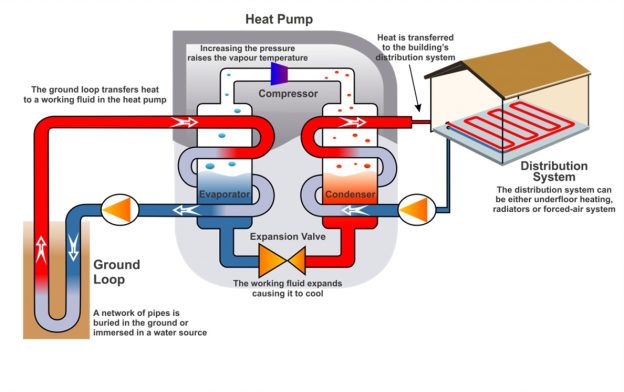A ground source heat pump, also known as a geothermal heat pump, is a heating and cooling system for structures that use a specific thermal heat pump to transfer heat to or from the ground, utilizing the earth’s relatively constant temperatures throughout the year. Geothermal heat pumps, also known as ground source heat pumps, are among the most energy-efficient technologies for delivering HVAC and water heating. They consume far less energy than resistive electric heaters or burning fuel in a boiler or furnace. Liquid-to-water heat pumps are hydronic systems that distribute warmth or cooling to baseboard heaters, conventional radiators, underfloor heating, and hot water tanks through the building’s pipes. For pool heating, these heat pumps are also favored. Boilers normally run at 65-95 °C (149-203 °F), whereas heat pumps typically only efficiently heat water to around 55 °C (131 °F). When upgrading a home from a boiler to a heat pump, larger radiators may be needed since the size of radiators made for the higher temperatures generated by boilers may be too small for use with heat pumps. Water-to-air heat pumps, also known as liquid-to-air heat pumps, produce forced air and are most frequently used to replace central air conditioning and older forced air furnaces. Split systems, high-velocity systems, and ductless systems are all possible variations.
A ground heat exchanger in contact with the ground or groundwater is used by ground source heat pumps to extract or release heat. Accurate system design is essential to a successful system since poor design can lead to the system freezing after several years or to very inefficient system performance. The effectiveness of a heat pump is influenced by efficient compressors, variable-speed compressors, and larger heat exchangers. Currently, available residential ground source heat pumps have standard COPs between 2.4 and 5.0 and EERs between 10.6 and 30. Heat pumps must achieve specific minimum COP and EER values, which vary depending on the kind of ground heat exchanger, to be eligible for the Energy Star label. The ISO 13256-1 heating COP and cooling EER for closed-loop systems, respectively, must both be 3.3 or higher.
The soil at depths of several meters or more and without the addition or removal of artificial heat maintains a fairly steady temperature throughout the year. This temperature is about equivalent to the location’s normal yearly air temperature, which in the north of the US is around 7–12 °C (45–54 °F) at a depth of 6 meters (20 ft). Ground-source heat pumps outperform air conditioners and air-source heat pumps during extremely high air temperatures because this temperature is more consistent throughout the seasons than the air temperature. The diversity of the time and space scales involved presents a challenge in estimating the thermal response of a ground heat exchanger (GHE). The heat transport of GHEs involves eight time periods and four spatial dimensions. The diameter of the borehole ( 0.1 m) and the corresponding duration are the first spatial scales of practical significance. During this time, the effect of the heat capacity of the backfilling material is substantial. The half distance between two nearby boreholes, which is on the scale of several meters, is the second crucial dimension of space. The matching period, which is around a month, is crucial for the thermal interaction between nearby boreholes.
By utilizing interseasonal heat transfer and seasonal thermal energy storage, ground source heat pumps’ efficiency can be significantly increased. Thermal banks allow for the efficient retrieval of heat that was caught and stored over the summer. The importance of this advantage is greatest in commercial or district heating systems because heat storage efficiency rises with scale. Additionally, by using big, affordable, water-filled solar collectors, tiny heat pump installations already in place can increase their efficiency. By inserting one-inch PE pipes into the outer layer, they can be integrated into a parking lot that is being renovated, as well as in wall or roof projects.
Thermal Performance of Ground Source Heat Pumps
on 25/10/2023








